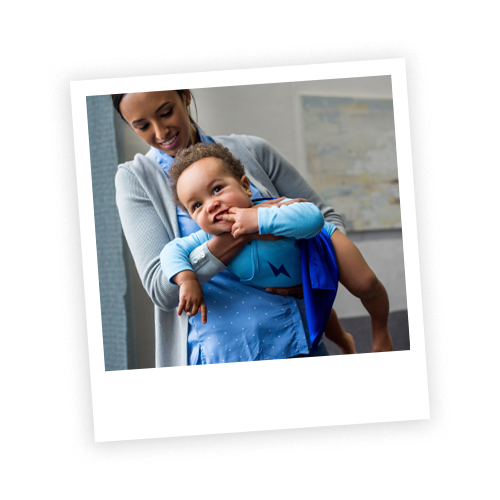
“We are realistic about the prospect of the child not staying with us, but we still believe that it is a win-win situation for the child; they will either stay with us, having experienced no moves, or they will return to a member of the birth family, which has to be the best thing, if possible.”
What is Adopting through Early Permanence?
Adoption West believe that Early Permanence provides the best possible futures for children, we therefore give all our prospective adopters the chance to explore this option through training. The majority of adopters are approved as Early Permanence foster carers, so that our children experience fewer moves in their lives and can be placed with a family as early as possible; however, it is a personal choice, and you will be given the option to ‘opt out’ of becoming an Early Permanence foster carer to follow a more traditional adoption journey.
Early Permanence is usually, but not exclusively, used for babies and young children coming into care, they have a high risk of being unable to return safely to the care of their birth families. They are likely to need adoption but still have a chance of being reunited with their birth families. If the court decides a child’s future is best protected by adoption, the child already has a secure attachment to their carers who are now able to adopt the child.
Early Permanence are placements for a child with approved adopters which are made where there is a possibility of adoption but no authority of the court or consent for the child to be adopted. Adoption West makes Early Permanence placements using a legal mechanism which enables adopters to be temporarily approved as foster carers for a child. Whilst Early Permanence is often associated with babies, it is can also be used for older children. This planning for children aims to provide the child with a temporary foster placement but with the potential for this to become their permanent home if they need to be adopted’ (Fostering for Adoption: A child-centred solution. A guide for prospective FfA carers).
Adoption West work in partnership with Local Authorities within the Region to place children with prospective adopters who are temporarily approved as foster carers for that child, where the need is identified. These placements are valuable for children, where the plan for adoption is a strong possibility, but the Local Authority have not yet ruled out the likelihood of the child being reunified with birth family and are used prior to the Court making a final decision about the child’s future. The child’s temporary foster placement with their Early Permanence foster carer(s) can later become one of adoption, provided the relevant court orders are obtained. This means that children can be placed with their future adoptive family at the earliest possible stage, reducing the delay for the child and the potential for them to have to make a further move.
As there will be on-going visits from Social Workers, and birth family meetings, the geographical location of the placement will need to be taken into consideration and balanced against the impact of the child travelling long distances to contact The child’s needs will be central to decision making around placement location.
Adoption West also provide early permanence placements to older children, some of whom will have been in the care of the Local Authority for some time and where a return home to family has proved unsuccessful.
Research shows that the longer the delay and the greater the number of foster placements, the greater the potential for damage to children’s mental health and development. Early Permanence placements are intended to lay the foundations for improved health and emotional wellbeing throughout the child’s life, by giving more stability during the vital early years of development. Early Permanence placements are already showing positive results in limiting delay and securing better outcomes for children where adoption is the likely path to permanence.
Early permanence shifts the stress and uncertainty about future placements from the child to the adults in the system and provides protection for the child against the impact of delay. Early permanence for babies and young children lays the foundations for greatly improved health and emotional wellbeing throughout the child’s life by giving more stability during the vital early years of development.
The child is placed with their potential adopter(s) as early as possible, providing stability and consistency of care at an early stage, which enhances the likelihood of them developing a secure attachment.
For babies and young children, it allows the early months of the child’s life to be as settled and secure as possible at a time in their development that this is vital. The potential disruption and trauma to the child, caused by having to separate from their foster carer(s) to whom they have become attached, is reduced.
- It can speed up the planning for vulnerable babies and young children
- Acquires a ‘secure base’ in attachment terms; it avoids the trauma and damage caused by moves in care if terminating temporary foster care relationships which children will have experienced as their primary parenting relationship
- Develop a sense of belonging and a robust, positive identity
- Have a sense of security; It allows the early months and years of the child’s life to be what most children need and expect
- Develop close trusted familial relationships; the bonding period with their adoptive parents can begin sooner, giving both child and carers the opportunity of forming a close and secure attachment
- Predict their future; avoids the chance of the child getting older in care and never having the opportunity to be adopted.
- The bonding period with their adoptive parents can begin sooner giving both child and carers the opportunity of forming a close and secure attachment
- For young children, the carer(s) will be part of the child’s early life experiences and will have a deeper understanding of their life story.
- Adoptive parents will have had the opportunity to get to know their child’s birth parents at contact sessions and will be in a good position to understand their background and struggles. This will be helpful for them and their adopted child in the future when adopters are talking to their child about the reasons their birth family were unable to care for them.
Early Permanence foster carers are expected to work with the Local Authority Fostering Service for the child whilst court proceedings are ongoing. During the fostering period, it is likely that the child will have regular supervised contact with their birth family.
Early permanence foster carers need to be extremely child-centred and have the emotional resilience to accept that one outcome of the court process may be a decision that the child in their care should return home to their birth parents or birth family.
In Early Permanence placements, the emotional uncertainty associated with possible and actual placement moves is held by the adults rather than experienced by the child in placement moves. Early Permanence foster carers need accept that these challenges are worth taking on; you will be supported throughout the process.
- The child can be placed before all the assessments of the parent(s) have been fully completed and before therefore the final care plan is known. At this point the Local Authority cannot predict the final decision of the Court.
- The court process is typically 26 weeks (around six months) and can go on for longer if there are delays with assessments.
- The child may be placed before all the possibilities for the child to be cared for within the birth family and connected network, have been fully ruled out
- The information available about the child at the point of them being placed with you is likely to be limited and will not be as full as that which you would have access to traditionally at the point of matching. This means the child’s individual needs may not be fully known at the point of them being placed
- The child is likely to continue to have on-going contact with their parent(s) and possibly with wider family members up until the final court hearing. You will be involved in supporting these meeting arrangements with the parents and possibly wider family members, possibly transporting the child to and from family time. This might include virtual contact. If you want to know more about contact, you can read here (include link to case studies) how some adopters have experienced this.
- While placing a child in an Early Permanence placement is intended to avoid the disruption of the child’s attachment to their primary carer, until the Court authorises the child’s placement for adoption, the placement remains temporary.
- Early Permanence carers have no legal rights over the child and if their care plan changes and the child needs to be moved to an alternative placement
- You must also be prepared to support a child to be returned to the care of their birth family, if this is determined by the court to be in the child’s best interests.
Since April 2015, prospective adopters who foster their child prior to adopting them are eligible for adoption leave and pay https://www.gov.uk/adoption-pay-leave. It is likely you will be required to leave work at short notice if you have a child placed with you through Early Permanence, and therefore you will need to have supportive employers.
As a foster carer, you will be entitled to a fostering allowance from the Local Authority responsible for placing the child, which will end if the placement becomes one of adoption.
There will be a few things you will need to think about in relation to Early Permanence. Initially, as a foster carer, you are caring for the child under fostering regulations, as approved by the child’s Local Authority, so you will need to consider whether this is something with which you are comfortable, primarily the fact that you will not be able to regard the child as your own. You will need to be mindful that you are not yet ‘mummy’ and/or ‘daddy’.
It is likely you will go on to adopt the child, but you will need to be able to manage the uncertainty of other outcomes. You will need to think about the possibility of the Court not agreeing a plan for adoption and the child leaving your care. If you already have a child, whether they are a birth or adopted child, you will need to consider the impact on them as well as yourselves if the child does not remain in your care. Preparation and support for other children in the home is essential.
It is important for you to consider what support you might need around you and how you typically deal with stressful or painful situations and there are specific issues about preparing for the period of uncertainty in the fostering phase of Early Permanence. You will be encouraged to discuss this with your family members and close friends. Members of your network may have questions and views themselves, but they also need to be a reliable source of support for you.
- Very adaptable – can manage the dual role as foster carers and possibly then adopters.
- Child centred – willing to take on emotional pain and uncertainty so the child doesn’t have to.
- Very resilient – can cope with the idea of and the actual potential loss of the child.
- Able to manage (practically and emotionally) the arrangements for the child’s time with their birth family.
- Able to manage the anxiety and uncertainty during proceedings.
- Well supported – with a robust support network who also understand EP.
- Well prepared – having received specialised preparation, assessment and support.
Becoming an Early Permanence foster carer is not suitable for all prospective adopters. You and your support network will need to be emotionally resourceful, flexible, and able to manage uncertainties. Adoption West believes that this model is child-centred because it is the adult making an informed choice to manage this period of uncertainty whilst the child experiences good quality, uninterrupted and consistent care. Insert Adoption West social workers will support and guide you through this process. You will also be linked up with experienced Early Permanence carers for advice and support and receive supervision from a social worker in accordance with fostering regulations.
You can discuss all of the implications with your assessing social worker during your home study and there will be information available during the preparation stage as you journey towards becoming an adoptive parent. It can be arranged for you to talk to other adopters who have provided Early Permanence placements, to give you more of an idea of how this type of placement might impact on you and your family. Insert AdoptionWest also provide a one-day training event on Early Permanence, which all prospective adopters are required to attend.
- If you’d like to learn more about some of the challenges and rewards of Early Permanence in general, you can listen to the experiences of other adopters via First4Adoption Webcasts.
“Whilst we ultimately wanted to adopt a child, we were also interested in fostering. Early Permanence gave us the opportunity to do both and we thought hard about how we would feel if a child were to return to the birth family, and whether or not we could cope with it. The outcome for us was positive as the child we had in a early permanence placement has stayed with us, meaning we had them 4 or 5 months earlier than we otherwise would have – this enabled us to work on attachment at a critical stage which we would have missed out on if they’d gone through traditional adoption. The process was incredibly challenging but it was worth it a hundred fold. It is impossible to know the risk and likelihood of the child going back to birth family so it’s important that early permanence carers feel able to cope with this potential eventuality and have a good support network. Whatever the outcome, you’ll be doing something wonderful and important for a child that really needs it – and possibly for the first time in their life, the adults will be taking the risk so that they don’t have to.”






